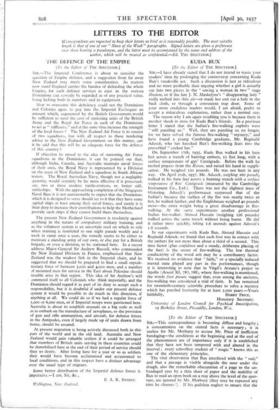KUDA BUX [To the Editor of THE SPECTATOR.] SIR,—I have
already stated that I do not intend to waste your readers' time by prolonging the controversy concerning Kuda Bux's vaudeville act. Such a discussion is just as ridiculous and no more profitable than arguing whether a girl is actually cut into two pieces in the " sawing a woman in two " stage illusion, or if the late J. N. Maskelyne's " disappearing lady " really melted into thin air—or made her exit via a hole in the back cloth, or through a convenient trap door. Some of your more credulous readers would, I am afraid, prefer to accept a miraculous explanation, rather than a normal one.
The reason why I am again troubling you is because there is another shock in store for Kuda Bux's friends. In a previous letter I stated that the Indian's fire-walking exploits were " still puzzling us." Well, they are puzzling us no longer, for we have solved the famous fire-walking " mystery," and have found a young Cambridge graduate, Mr. Reginald Adcock, who has knocked Bux's fire-walking feats into the proverbial " cocked hat."
On September 17th, 1935, Kuda Bux walked in his bare feet across a trench of burning embers, II feet long, with a surface temperature of 430° Centigrade. Before the walk he recited prayers from the Koran, and raised his hand in suppli- cation. He weighed 120 pounds. He was not hurt in any way. On April zoth, 1937, Mr. Adcock, weighing 160 pounds, walked in his bare feet across a burning trench with a surface temperature of Soo' Centigrade (measured by the Cambridge Instrument Co., Ltd.). There was not the slightest trace of blistering. Adcock's performance surpassed that of the Indian's because the surface of the fire was nearly twice as hot, he walked farther, and the Englishman weighed 4o pounds more—the extra weight being a great disadvantage in fire- walking. At the same experiments- another professional Indian fire-walker, Ahmed Hussain (weighing 126 pounds) walked across the same trench without being burnt. He did it rather more quickly, taking 1.6 seconds against Adcock's 1.8 seconds.
In our experiments with Kuda Bux, Ahmed Hussain and Reginald Adcock, we found that each foot was in contact with the embers for not more than about a third of a second. This time factor (plus confidence and a steady, deliberate placing of the feet) is the secret of fire-walking. The low thermal conductivity of the wood ash may be a contributory factor. We received no evidence that " faith," or a specially induced mental state played any part in the performances, though it is interesting to note that in Virgil's Arruns's prayer to Apollo (Aeneid XI, 787, 788), where fire-walking is mentioned, the words freti pietate suggest that, even among the ancients, fire-walking was considered a trial of faith. It has remained for twentieth-century scientific procedure to solve a mystery which has puzzled humanity for at least 2,000 years.—Yours
Honorary Secretary.
University of London Council for Psychical Investigation, rg Berkeley Street, Piccadilly, London, W.r.


































































 Previous page
Previous page